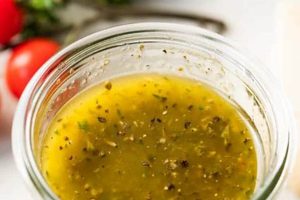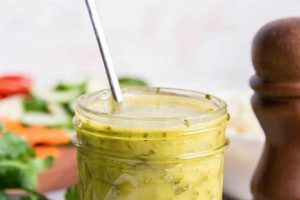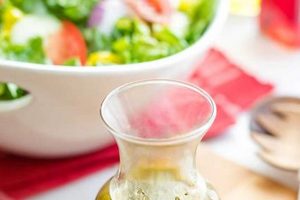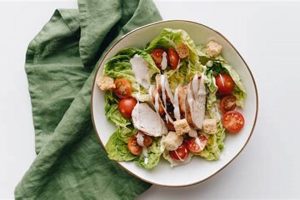Recipes for salad dressings that minimize caloric intake typically focus on reducing added fats and sugars while maximizing flavor through herbs, spices, citrus juices, and vinegars. For example, a simple vinaigrette can be made with olive oil, lemon juice, Dijon mustard, and black pepper.
Health-conscious individuals often seek ways to reduce dietary fat and sugar. Dressings prepared with these principles contribute to lower overall calorie consumption, supporting weight management and potentially reducing the risk of certain health issues. Furthermore, the emphasis on fresh ingredients aligns with broader dietary trends emphasizing whole foods and natural flavors.
This article will delve into specific examples of such recipes, exploring diverse flavor profiles, ingredient variations, and practical tips for preparation and storage. It will also address common concerns, such as achieving desired textures and balancing flavor complexities.
Tips for Creating Delicious Low-Calorie Salad Dressings
Creating flavorful, low-calorie salad dressings involves strategic ingredient choices and preparation techniques. The following tips offer guidance for achieving delicious results without compromising dietary goals.
Tip 1: Embrace the Power of Vinegar: Vinegar provides acidity and complexity with minimal calories. Experiment with different types, such as apple cider, balsamic, red wine, or white wine vinegar, to find complementary flavor profiles for various salads.
Tip 2: Maximize Flavor with Herbs and Spices: Fresh or dried herbs and spices add depth and interest without contributing significant calories. Consider options like dill, mint, oregano, parsley, chives, garlic powder, or onion powder.
Tip 3: Citrus Fruits: A Burst of Flavor: Lemon, lime, and orange juice offer vibrant acidity and sweetness. A small amount can significantly enhance a dressing’s flavor profile.
Tip 4: Greek Yogurt: A Creamy Alternative: Plain, nonfat Greek yogurt can replace higher-calorie ingredients like mayonnaise or sour cream, adding creaminess and a tangy note.
Tip 5: Mustard: A Flavor Enhancer: Dijon, stone-ground, or yellow mustard contribute a distinct pungency and depth of flavor. They also act as excellent emulsifiers, helping to bind ingredients together.
Tip 6: Controlled Use of Healthy Fats: While minimizing added fats is crucial, a small amount of healthy fat, such as extra virgin olive oil or avocado oil, can enhance flavor and texture. Measure carefully to maintain caloric control.
Tip 7: Adjust Seasoning Gradually: Start with small amounts of seasonings and adjust incrementally to achieve the desired balance. Taste-testing throughout the preparation process is crucial.
By following these tips, individuals can create a wide array of healthy and flavorful salad dressings, transforming simple salads into satisfying and nutritious meals. These strategies empower one to enjoy flavorful salads without compromising health goals.
The following section will explore specific low-calorie salad dressing recipes, showcasing the practical application of these principles.
1. Ingredient Selection
Ingredient selection is paramount in crafting low-calorie salad dressings that deliver both flavor and health benefits. Careful consideration of each component’s nutritional value and flavor contribution ensures a final product that aligns with dietary goals without compromising taste.
- Vinegars as Flavor Bases
Vinegars contribute acidity and complexity with negligible calories. Apple cider vinegar offers a mild sweetness, while balsamic vinegar provides a rich, tangy flavor. Red and white wine vinegars impart nuanced notes depending on the grape variety. Selecting the right vinegar establishes the foundation of the dressing’s flavor profile.
- Fresh Herbs and Spices for Depth
Fresh herbs like parsley, dill, mint, and chives, or dried spices like garlic powder, onion powder, and paprika, introduce layers of flavor without adding significant calories. Their aromatic qualities enhance the overall sensory experience.
- Citrus Juices for Brightness
Citrus fruits, including lemons, limes, and oranges, contribute a vibrant acidity and a touch of natural sweetness. A small amount of juice can significantly elevate a dressing’s flavor profile, adding brightness and complexity.
- Fat Sources: Quality over Quantity
While minimizing added fats is crucial in low-calorie dressings, a small quantity of healthy fat enhances flavor and texture. Extra virgin olive oil or avocado oil, used sparingly, can create a more satisfying and palatable dressing.
By strategically selecting and combining these core ingredients, one can create a diverse range of low-calorie salad dressings suitable for various greens and toppings. The interplay of vinegar, herbs, spices, citrus juices, and minimal healthy fats allows for maximum flavor impact while adhering to dietary restrictions. This approach prioritizes both taste and health, making mindful ingredient selection the cornerstone of successful low-calorie dressing creation.
2. Calorie Control
Calorie control is central to the concept of low-calorie salad dressing recipes. Managing caloric intake through mindful ingredient choices and portion sizes is essential for weight management and overall health. Understanding how different components contribute to a dressing’s caloric load empowers individuals to make informed decisions aligned with dietary goals.
- Fat Content
Fats are the most calorie-dense macronutrient. Traditional salad dressings often rely heavily on oils, which, while contributing flavor and texture, significantly increase caloric content. Low-calorie alternatives prioritize minimizing added fats or substituting them with lower-calorie options. For example, using a small amount of a flavorful oil like extra virgin olive oil or incorporating a water-based emulsion can significantly reduce overall calories compared to dressings heavily reliant on mayonnaise or creamy dressings.
- Sugar Content
Added sugars contribute calories without providing substantial nutritional value. Many commercial dressings contain added sugars to enhance flavor or sweetness. Low-calorie recipes minimize or eliminate added sugars, relying on natural sweetness from ingredients like fruits or vegetables, or utilizing non-caloric sweeteners when necessary. This focus on natural flavors reduces empty calories and promotes healthier choices.
- Portion Size
Even with low-calorie ingredients, portion control remains critical. Consuming excessive amounts of any food, regardless of its caloric density, can hinder weight management efforts. Using measuring tools and being mindful of serving sizes ensures that even healthy choices contribute to overall caloric goals. For example, a small amount of a flavorful, low-calorie vinaigrette can enhance a salad without adding excessive calories, while a large portion of the same dressing could negate its benefits.
- Ingredient Swaps
Strategic ingredient substitutions offer a powerful tool for calorie control. Replacing high-calorie components with lower-calorie alternatives while maintaining flavor and texture is key. For instance, using Greek yogurt in place of mayonnaise or sour cream in creamy dressings reduces calories and adds protein. Similarly, pureeing roasted vegetables can add creaminess and flavor without the high caloric load of traditional creamy ingredients.
By addressing these facetsfat content, sugar content, portion size, and ingredient swapslow-calorie salad dressing recipes provide a pathway to enjoying flavorful salads without compromising dietary objectives. These principles enable individuals to create dressings that support their health goals while enhancing the culinary experience.
3. Flavor Balancing
Flavor balancing is crucial in low-calorie salad dressing recipes. Since reducing caloric density often involves limiting fats and sugarskey components contributing to richness and palatabilitycareful balancing of remaining ingredients becomes essential. The goal is to create a dressing that is both light and flavorful, compensating for the absence of traditional sources of richness. A well-balanced low-calorie dressing should offer a complex interplay of tastesacidity, sweetness, saltiness, bitterness, and umamiwithout relying on excessive calories. For example, a lemon vinaigrette balances the tartness of lemon juice with a touch of sweetness from a small amount of honey or maple syrup, rounded out by the subtle bitterness of extra virgin olive oil and a pinch of salt. This interplay creates a harmonious flavor profile despite the low caloric content.
Achieving flavor balance in low-calorie dressings necessitates understanding the roles of different ingredients. Acids, like vinegar and citrus juices, provide brightness and sharpness. Herbs and spices contribute depth and complexity. A touch of sweetness, from natural sources like fruit or a minimal amount of honey or maple syrup, can temper acidity and enhance overall palatability. Salt enhances other flavors and provides a savory counterpoint. Utilizing umami-rich ingredients, such as a small amount of grated Parmesan cheese or a splash of soy sauce or Worcestershire sauce (in moderation due to sodium content), can add a savory depth that compensates for the reduced fat content. Careful consideration of these elements allows for the creation of dressings that are both flavorful and aligned with dietary goals.
Mastering flavor balancing elevates low-calorie salad dressings from simple, diet-conscious choices to genuinely enjoyable culinary experiences. It allows individuals to adhere to dietary restrictions without sacrificing flavor satisfaction, promoting long-term adherence to healthy eating habits. The interplay of taste components creates a symphony of flavors that compensates for reduced caloric density. This approach underscores that healthy eating does not necessitate blandness, but rather emphasizes a deeper understanding of flavor dynamics and strategic ingredient combinations.
4. Preparation Methods
Preparation methods significantly influence the final quality and characteristics of low-calorie salad dressings. Proper techniques ensure optimal emulsification, texture, and flavor integration, maximizing the sensory experience while adhering to dietary constraints. Different preparation methods yield distinct results, affecting the dressing’s stability, consistency, and overall palatability.
Emulsification, the process of combining two immiscible liquids (typically oil and vinegar), is crucial for creating a stable and homogenous dressing. Whisking vigorously by hand creates a temporary emulsion suitable for immediate use. For more stable emulsions, a blender or food processor creates a finer texture and more thorough integration, preventing separation. The choice of method depends on the desired consistency and the ingredients involved. For example, a simple vinaigrette benefits from hand-whisking, while a creamy dressing containing Greek yogurt might require blending for a smoother texture. Understanding these nuances allows for greater control over the final product.
The order of ingredient addition can also impact the final outcome. Generally, combining acidic ingredients, such as vinegar or citrus juice, with seasonings like herbs, spices, and sweeteners before adding oil allows the flavors to meld and distribute evenly. Gradually whisking or blending in the oil while the other ingredients are already combined promotes a more stable emulsion. This approach ensures that flavors are balanced and that the oil is properly incorporated, preventing a greasy or separated dressing.
Proper preparation techniques are essential for maximizing the sensory appeal and practicality of low-calorie salad dressings. They ensure optimal texture, flavor integration, and stability, contributing to a more satisfying and enjoyable culinary experience. Selecting appropriate methods based on the desired outcome empowers individuals to create dressings tailored to specific preferences and dietary needs.
5. Storage Techniques
Proper storage techniques are essential for maintaining the quality, flavor, and safety of low-calorie salad dressings. These dressings, often relying on fresh ingredients like herbs, citrus juices, and yogurt, can be susceptible to spoilage or flavor degradation if not stored correctly. Effective storage preserves the intended flavor profile, texture, and nutritional value, maximizing shelf life and preventing bacterial growth. For instance, a vinaigrette containing fresh herbs, stored improperly at room temperature, could experience rapid herb degradation and potential bacterial growth. Conversely, proper refrigeration in an airtight container maintains its freshness and flavor for an extended period.
Refrigeration is the cornerstone of proper storage for most low-calorie salad dressings. Airtight containers are crucial for preventing oxidation, preserving volatile flavor compounds, and minimizing exposure to airborne contaminants. Glass containers are generally preferred over plastic due to their non-porous nature, which prevents absorption of flavors or odors. Proper labeling with preparation dates allows for easy identification and ensures consumption within a safe timeframe. Most low-calorie dressings, especially those containing fresh ingredients, should be consumed within a week for optimal quality. Separation may occur in some dressings upon refrigeration; a gentle shake or whisk before serving typically restores the desired emulsion.
Careful storage practices directly impact the quality and longevity of low-calorie salad dressings. These techniques safeguard flavor integrity, maintain nutritional value, and prevent foodborne illnesses. By adhering to proper refrigeration and storage guidelines, individuals can maximize the shelf life of their homemade dressings, ensuring both safety and enjoyment. This attention to detail contributes to a more satisfying and healthful culinary experience, reinforcing the importance of proper storage as an integral component of low-calorie salad dressing preparation.
Frequently Asked Questions
This section addresses common inquiries regarding low-calorie salad dressing recipes, providing clear and concise information to facilitate informed decision-making and successful recipe implementation.
Question 1: How can one reduce the fat content in creamy salad dressings without sacrificing creaminess?
Substituting plain, nonfat Greek yogurt for mayonnaise or sour cream provides a healthier alternative while retaining a creamy texture. Pureeing silken tofu or cooked cauliflower can also contribute creaminess with minimal added fat.
Question 2: What are effective strategies for enhancing flavor complexity in low-calorie dressings?
Layering flavors through a variety of herbs, spices, and citrus juices adds depth without increasing calories. Incorporating ingredients like roasted garlic, Dijon mustard, or a small amount of grated Parmesan cheese can also boost flavor complexity.
Question 3: How can one ensure that homemade low-calorie dressings emulsify properly and remain stable?
Proper emulsification techniques, such as gradually whisking in oil to an acid base or using a blender or food processor, create a stable emulsion. Adding a small amount of mustard can also act as an emulsifier.
Question 4: What storage practices maximize the shelf life of homemade low-calorie salad dressings?
Refrigeration in airtight containers, preferably glass, preserves freshness and prevents spoilage. Labeling with preparation dates ensures consumption within a safe timeframe.
Question 5: Are low-calorie salad dressings suitable for all types of salads?
Different types of salads benefit from different dressing profiles. Light vinaigrettes complement delicate greens, while heartier salads may benefit from more robust flavors. The dressing should complement the salad’s ingredients.
Question 6: Can low-calorie dressings be adapted for specific dietary needs, such as vegan or gluten-free diets?
Most recipes can be adapted by substituting ingredients. For vegan dressings, ensure all components are plant-based. For gluten-free dressings, verify that all ingredients, including seasonings, are certified gluten-free.
Understanding these key considerations ensures the creation of flavorful and healthful low-calorie salad dressings that align with individual dietary needs and preferences.
The following section offers specific low-calorie salad dressing recipes, demonstrating the practical application of these principles.
Conclusion
Low-calorie salad dressing recipes offer a pathway to enjoying flavorful and healthful salads without compromising dietary goals. Strategic ingredient selection, emphasizing fresh produce, herbs, spices, and vinegars, allows for diverse flavor profiles while minimizing added fats and sugars. Careful attention to calorie control, flavor balancing, preparation methods, and storage techniques ensures optimal quality, taste, and longevity. Addressing common questions regarding ingredient substitutions, flavor enhancement, emulsification, and storage empowers individuals to create and enjoy delicious, low-calorie dressings tailored to individual preferences and dietary needs.
The exploration of low-calorie salad dressing recipes underscores the potential for culinary creativity within dietary constraints. By understanding the underlying principles of flavor balancing and ingredient interaction, individuals can transform simple salads into satisfying and nutritious meals. This approach promotes long-term adherence to healthy eating habits, demonstrating that dietary restrictions need not limit culinary enjoyment but rather inspire innovative approaches to flavor and nutrition.






